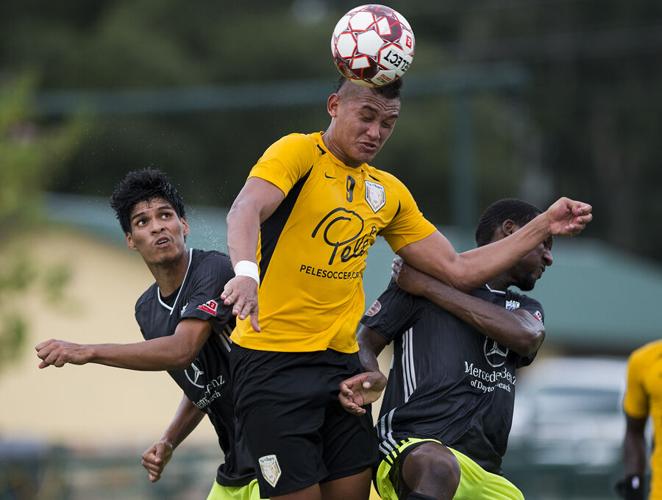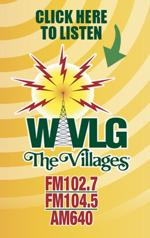Anyone venturing into downtown Orlando on a spring Saturday is liable to catch a glimpse — and likely a whiff — of dense purple smoke. On match days, Church Street transforms into a sea of flags, chants and face paint as the loyal fans of the Orlando City Soccer Club file into Exploria Stadium. Amidst the throng can always be spotted a contingent of young footballers, kids decked out in Lions’ purple but wearing their own self-dirtied cleats. Florida is leading the charge as soccer has grown in popularity in the United States, both as a pastime and a spectator sport — and the two are closely linked. “By having Orlando City, the MLS team, do you know how many kids are going to watch higher-level players play?” said Anderson DaSilva, founder of The Villages Soccer Club and coach of The Villages SC.
“Now we have Inter Miami, the Rowdies have been there for a long time. And it’s a state where we can play all year-round, we don’t have to stop.”
With the professional squads already competing with other major sports teams in terms of fandom and the youth soccer scene constantly growing, Florida is, indeed, fertile ground for America’s coming soccer movement to take root.
Youth Soccer
Soccer is among the most popular athletic activities for youth in Florida. The state ranks second behind only the much more populous California in youth participation numbers.
The reason? As is the case for much of Florida’s abundant sports scene, climate is a leading factor.
“Both Florida and California, as much as you can look at the numbers and the population and all that, you have the capacity to play year-round, which is huge,” said Jill Ellis, former coach of the U.S. Women’s National Team and a current Florida resident. “When you look at some of the northern states, it’s a huge advantage to be able to play year-round outside.”
Some of the highest-profile youth competitions in the country are played in Florida. Each year, the Elite Clubs National League holds one of its six national tournaments in Sanford. This past January, more than 250 teams entered in the boys and girls competitions at Seminole Soccer Park.

The Villages SC's Gabriel Cabral de Freitas, left, heads the ball over Florida Elite SA's Nicholas Lodovico, center, during a 2019 match at The Villages SC's stadium.
While participation numbers in youth soccer have fluctuated slightly in recent years (complete data for 2020 is unavailable due to inconsistencies caused by the COVID-19 pandemic), the game remains one of the most popular among people under 20, with consistent growth over the long haul.
“There has been tremendous growth from 1990 to 2021,” said Kai Velmer, president of the Florida Youth Soccer Association. “Youth soccer is part of the fabric of our everyday life now.”
Availability
There are also ample opportunities for young players to get involved in the sport in Florida.
The FYSA alone consists of more than 200 clubs and leagues, populated by more than 100,000 players.
Even as numbers have declined slightly in recent years, the infrastructure around youth soccer has grown.
“The game has professionalized more and more,” Velmer said. “There’s a lot more focus than 20 or 30 years ago, when it was more grass-roots.”
Even with that shift, the majority of coaches in Florida are still volunteers, which emphasizes the need for additional training and education, especially in the cases of programs aimed at preparing players for higher levels of soccer.
“I think the key is we have so many kids that want to play and, most of the time, I don’t think we have enough fields and coaches,” said DaSilva, a U.S. Soccer Class A-certified coach who also coaches the boys varsity soccer team at The Villages High School.
“The kids, they’re watching soccer on TV more, they’re watching live soccer more, so we need coaches that know what they’re talking about and what they teach, so the kids can stay motivated.”
The flip side of that coin is that highly-qualified and well-paid coaches increase the cost of the game, already a concern at higher youth levels where participation can mean pricey club fees and extensive travel. This has become a growing concern for Velmer, who grew up in Germany until age 10, playing with kids from diverse economic and cultural upbringings.
“In the U.S., I don’t know that we’re reaching players from all different backgrounds because the cost can be so prohibitive,” he said. “It’s not a sport for all like it is in Europe. It is at the recreational level but not when you get to those higher levels.”
Academy Programs
In addition to recreational soccer for young players, there are also dozens of high-level academy teams in Florida.
In 2020, MLS launched MLS Next, a program for high-level youth players. The league, currently in its first season, already includes 489 teams spanning ages 13-19 in 25 states, Washington D.C., and three Canadian provinces.
Just this month, Orlando City announced the creation of two new academy programs in Central Florida, one each in Seminole and Osceola counties, both of which will compete in MLS Next.
“We’re excited to provide even more Central Florida youth players with the opportunity to participate in the highest platforms of the youth programs in the USA,” Orlando City Head Coach Oscar Pareja said. “The importance of marrying the structure, methodology and development philosophy of the first team to the youth program is critical to what we’re building here at Orlando City.”
The United Soccer League also launched a targeted youth initiative in recent years with the USL Academy, of which The Villages Soccer Club is an inaugural member. The league is for players between the ages of 15 and 19 and provides some of the best competition available, according to DaSilva.
“That’s preparing our players a little bit better because, if we don’t enter these kind of leagues and our athletes reach the level that they can’t be challenged anymore, they’re going to start losing interest and they’re going to have a ceiling that they’re going to reach,” the coach said. “With this kind of league, we can challenge them to become a better player, to work harder, so that their ceiling is higher up into the D1 college and professional levels.”
International powers FC Barcelona and Paris Saint-Germain F.C. also have academies in Orlando and Miami, respectively. While these sorts of academies often license the name of an established European brand and are very rarely pipelines to the first team, there are ways in which their association can be beneficial.
“It’s all about how the club is associated and how it’s structured,” Velmer said. “It can be a very positive thing. Professional clubs all over the world see the United States as up and coming and they want to tap into it. Obviously, that will evolve over time and we’ll see how that works.”
Semi-Pro
Soccer is one of few sports in America with a significant semi-professional footprint. Leagues such as USL League Two and the National Premier Soccer League exist across the U.S. Both leagues attract high-level amateur players and have established records of sending players off to the professional ranks, whether in the United States or abroad.
“Those players, a lot of them are on scholarship or a lot of them dream of getting drafted to the MLS, so the summer league, they use it to get in shape, to get the game rhythm, to be challenged, so that when they do start in college, they’ll be ahead of other players,” DaSilva said. “I think that’s the main reason why summer leagues are so successful with semi-professional teams.”
Florida is home to four members of the NPSL and the entirety of USL2’s Southeast Division, which, this year, includes six teams but has been larger in recent years.
The Villages SC, whose home facility resides in Summerfield, has been the top team in the division since arriving in the community in 2016. In four seasons (the 2020 USL2 season was canceled due to COVID), the Buffalo have won two division titles and a Southern Conference title in 2018.
The Villages SC has contended with organizations such as the Lakeland Tropics, which includes semi-professional and youth programs as well as a professional indoor side, SIMA Aguilas, a subsidiary of Montverde Academy, and Florida Elite SA, one of the top youth programs in the state, which launched its USL2 team in 2019.
Professional Soccer
Florida is also home to an increasingly robust professional soccer scene. As professional soccer has gained more of a foothold in the U.S. sports landscape, Florida teams have been at the forefront of that movement.
The state currently boasts two MLS clubs, Orlando City SC and Inter Miami FC, as well as the USL Championship Tampa Bay Rowdies and the NWSL’s Orlando Pride.
“I think it just speaks to the popularity of the sport,” said Ellis of Florida’s pro soccer presence. “I think it just says that Florida is a state that is serious about this game.”
Orlando City consistently ranks near the top of MLS in attendance. The club averaged 22,761 fans in 2019, better than either of their Florida NBA counterparts the Miami Heat or Orlando Magic and far outpacing baseball’s Tampa Bay Rays and Miami Marlins.
Inter Miami made its debut during the pandemic-stricken 2020 season. However, its inaugural game, played March 4, 2020, against LAFC, was the most-watched opening week MLS game on an ESPN channel since 2011. According to a release from the network, the Miami-Fort Lauderdale metropolitan area accounted for the largest portion of viewers — roughly three times as many as watched in the much larger Los Angeles market — with Jacksonville also contributing a large share of the total viewers.
“I think the numbers in viewership are steadily increasing. I think you can see it,” Ellis said. “If you look at a new club like the Atlanta MLS team, they regularly were getting 60,000 or 70,000 fans and selling out a football stadium at every match. I think the fanbase is there, I think it’s going to require more mainstream television exposure.”
American Stronghold
While only representing a portion of the population, Florida is one of the most important states in the country to American soccer, including at the national team level. The state, specifically Orlando, is a bastion for America’s squads, previously hosting national team and other international matches in the Gold Cup, SheBelieves Cup, and international friendly matches on both the men’s and women’s side, most of which fell in America’s favor.

Fans march together into Exploria Stadium ahead of Orlando City's 2020 season opener.
With the United States, Mexico and Canada sharing hosting duties for the 2026 World Cup, Orlando’s Exploria Stadium, already slated to house the USMNT’s extremely important match against Canada in the CONCACAF Nations League this November, became a natural selection for a match site in the sport’s greatest competition.
“Winning at home is critical in these tournaments, so finding a home-field advantage is important,” USMNT head coach Gregg Berhalter said. “When you talk about great environments, the atmosphere in this stadium is one of the best in the country. Like we’ve seen in previous visits, the fans in Orlando are there when you need them and we look forward to their support.”
It also significantly raises the soccer profile of the region.
“Being selected to host two USMNT games in the same year helps confirm what we know — that Orlando is a great soccer city,” said Jason Siegel, CEO of the Greater Orlando Sports Commission. “This provides another chance for our community to attend a tremendous international match as we welcome our North American World Cup partners from the North.”
Staff Writer Drew Chaltry can be reached at 352-753-1119, ext. 5233, or drew.chaltry@thevillagesmedia.com.










Commented
Sorry, there are no recent results for popular commented articles.